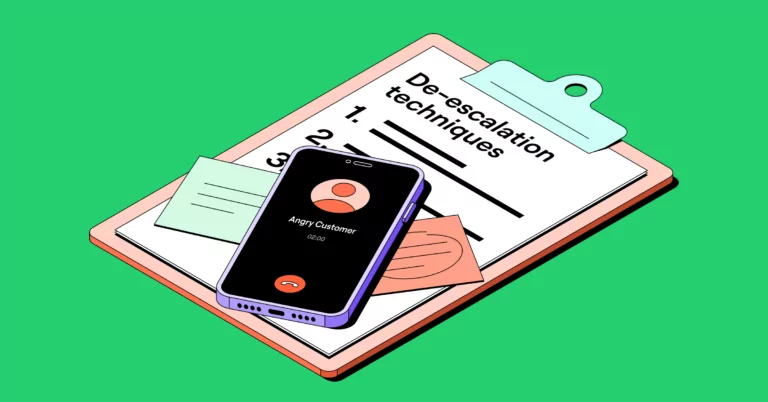Imagine interrupting a 4-year-old’s Bluey binge to tell them their daily allotment of screen time is up. Let the waterworks –– and the tricky task of de-escalating a preschooler –– ensue.
TV-loving children might not be synonymous with angry business customers, but the things that set them off are more similar than you might think:
- Misunderstandings and miscommunication
- Slow response times or no response at all
- Unmet needs, wants, or expectations
Plus, cranky customers are apt to leave bad reviews, exhaust your customer service reps, and, more often than not, switch to a competitor.
Your team has no doubt passed “de-escalation 101” with flying colors, regularly hauling out the ol’ active listening skills and harnessing a stay-calm attitude. But now you’re in the market for advanced de-escalation strategies.
In this article, we’ll share creative techniques to pull angry customers back from the brink and proactive ways to prevent customers from getting apoplectic in the first place.
But first, why do customers actually escalate?
Having a basic understanding of why a customer can get worked up is key to knowing how to de-escalate them.
The real reasons people get upset are rooted in their perception of how they’re being treated.
Conflict resolution expert Jeremy Pollack, PhD, says people tend to get angry when they feel:
- Unsafe
- Disrespected
- As if the person they’re interacting with doesn’t care about their situation
Support reps can set themselves up for success by using language that reassures customers they don’t need to worry about these perceived threats.
Encourage your team members to hone their communication skills and tap into positive psychology-based tactics to craft messaging that supports these counter-narratives.
In short, make sure no one on your team is checking their humanity at the door.
De-escalation 201: A 4-step system for calming angry customers
No one wants to be on the receiving end of another person’s rage. But, as every business leader knows, dealing with difficult customers is at least an occasional reality.
And these interactions present make-or-break moments: Two negative experiences will drive 76% of customers away. On the bright side, 94% of customers say a positive customer service
experience makes them more likely to purchase again.
So, training your team to handle these situations is truly non-negotiable. Fortunately, this research-backed four-step formula offers clear, practical guidance.
Step 1: Project a calm demeanor
Most customer service agents are well-schooled in the need to show they’re calm to de-escalate an unhappy customer –– a pretty difficult task when someone is screaming at you.
But research shows a person only has to appear calm and collected to diminish another person’s aggression.
So, have support staff use an even tone of voice that sounds authentic for them, maintain neutral facial expressions, and develop a list of go-to words and phrases that convey sincerity.
According to Jeremy, emotional escalation and problem-solving emerge from different areas of the brain, so there’s no capacity for multitasking here: Forget about troubleshooting until a disgruntled customer moves out of fight-or-flight mode.
To maintain a calm external presence, reps can:
- Remind themselves not to take anything personally: A frustrated customer is angry at their problem –– not a specific rep (in most cases).
- Use their breath: Taking deep breaths –– inhaling slowly for 5 seconds, holding for 3 seconds, then exhaling slowly for 5 seconds –– often has a fast-acting effect.
- Step away: If a member of your team finds they’re ultimately unable to project calmness, encourage them to use a strategic hold to buy themselves a break or set up a warm transfer to a colleague.
Step 2: Level up listening skills
Your team probably has active listening on lockdown: They ask open-ended questions, remember names and details, and use custom properties. They’re paying attention –– and the customer knows it.
But going a step further can help customers feel truly cared for in times of distress.
“Because we’re trying to resolve as much as we can, as quickly as possible, we often jump right into things,” says OpenPhone Customer Support Manager Drew Schuffenhauer. “If we take a second to make sure we fully understand the situation, gather all the information we need, and clarify anything as necessary before actually addressing the issue, it ultimately creates a better experience.”
To level up their listening skills, reps can:
- Incorporate mirroring: Mirroring, or the act of mimicking another person’s body language, speaking pace, word choice, and more has proven to make people more agreeable and even drive sales.
- Paraphrase customer complaints: Encourage reps to have customers walk them through the issue at hand, then sum up and repeat what they learned back to the customer. This helps confirm the rep fully understands the challenge and gives the customer an opportunity to clarify any details before replying to customer complaints.
Step 3: Show empathy
When a customer is angry, rather than going straight to solutions, you can get them to calm down by acknowledging and validating their pain.
A support agent doesn’t need to agree with all the details of a customer’s case to indicate they understand their perspective –– and apologize for the way things played out.
This is an exercise in showing care, consideration, and compassion. And remember, if a customer feels like the person on the other end of the line doesn’t care about their problem, that will only serve to stoke the flames of their anger.
To demonstrate empathy, reps can:
- Show a little emotion: While maintaining composure matters, no frustrated human wants to be consoled by a robot. If a rep can inject emotion into their speaking voice or the tone of their written messages, it signals to the customer they get it –– they’re aware problems like this can negatively impact many aspects of a person’s life.
- Give a genuine apology: Again, this isn’t about admitting wrongdoing; it’s about saying, “I’m sincerely sorry you’ve been through this upsetting experience. I’m going to help you.” A rep
- “I’m so sorry this happened. We’re going to make it right.”
- “I can only imagine how frustrating this has been for you. I know experiences like this can derail everything. I’m here to help you.”
- “I hear you, and I’m disappointed you had to go through this. I’m going to help you resolve this issue.”
Step 4: Provide reassurance and own the next steps
At this point, reps shouldn’t leave any doubt in the customer’s mind that they’re going to do everything in their power to solve the problem at hand.
At the end of calls, require reps to:
- Share clear next steps with the customer: This could mean transferring the customer to a colleague who specializes in a particular business area or taking time to investigate and follow up later. No matter what the next steps are, a rep needs to clearly explain what they’re going to do to arrive at a resolution (provided there is a solution to the problem).
- Then get the job done: The rep is now the manager of this problem, making sure to find a solution in a timely manner. Reps should update the customer along the way, inform them if they run into snags, and follow up once the issue has been rectified.
“It’s important to let the customer know what you’re doing with that ticket,” Drew says. “Based on the priority of a specific task, we try to give an idea of a timeline they can expect while never making any promise or guarantee we won’t be able to stick to.”
4 effective ways to get ahead of customer escalations
What’s better than successfully pacifying upset customers? Making sure they have nothing to get upset about in the first place.
These four best practices will help you curb customer anger before it starts.
#1: Establish (or revisit) your escalation management process
Document your escalation policies and procedures and review them on a regular basis. Include clarity around when a rep should shift a conversation to a manager and who owns which customer interactions.
Call escalation documentation can support your training efforts, acting as a study guide for new team members and an ongoing reference for customer-facing employees whenever they need a refresher.
#2: Provide a robust customer knowledge base
Work with your support operations team or whoever is fielding inbound tickets to identify the most common customer inquiries.
Then get ahead of those ticket submissions by letting frequently asked questions inspire help articles customers can access on their own. Establishing this type of self-serve knowledge hub also frees up time for reps to focus on more nuanced support challenges.
#3: Identify common reasons for escalations
Whether it’s a persistent bug, a breakdown in your customer service operations, or a billing approval hold-up, the same issues popping up over and over can frustrate reps and affect the quality of their service.
Ease the burden by mining call transcripts and recordings for the most common escalation catalysts. Make notes and create tags for different issues so you can easily pull data and analyze patterns.
Once you’re aware of the reasons behind most escalations, you can take action to resolve common issues and stop many future escalations in their tracks.
#4: Empower your team to handle any customer situation
As they say, practice makes perfect. And you want to make your team’s practice time as realistic as possible, so they feel confident going into any customer interaction –– curveball tickets and highly emotional customers included.
Role playing gives reps a safe space to refine how they’ll approach different customer scenarios, and call shadowing –– or acting as a “silent listener” on a customer call –– provides opportunities for reps to see best practices and new techniques in action.
OpenPhone customers can also use call transcripts to review conversations and learn from their colleagues. Each transcript features a call summary and a list of action items so your team has instant access to valuable insights, preventing things from falling through the cracks and, in turn, reducing the risk of escalations.
Related: Set your team up for success with a customer service training manual
Let OpenPhone help you short-circuit customer anger before it starts
Becoming a de-escalation expert isn’t just about knowing how to manage anger when it arises; it’s about getting ahead of issues, creating an environment where customers feel valued and understood, and enhancing the customer experience.
OpenPhone’s modern business communication technology supports every aspect of the de-escalation process –– and makes it easier to proactively prevent escalations before they start, with features like custom properties, call recordings, and automated call summaries.
If you found this de-escalation playbook helpful, share it with your team. Looking to build better rapport with your customers? Check out our guide to building better relationships.

